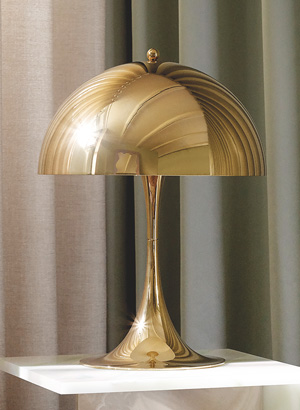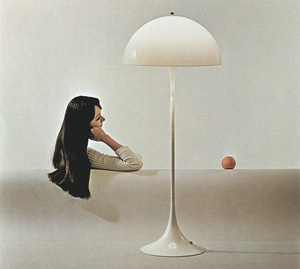Lighting the Way
Writer Ren MillerThe Panthella lamp helped to introduce new materials and innovative shapes in home furnishings 50 years ago

The Panthella 320 in metalized brass is a new size and finish created to mark the design’s 50th anniversary. Courtesy of Louis Poulson.
There is a great future in plastics,” an older man named Mr. Maguire tells a young Benjamin Braddock in the 1967 movie The Graduate. “Think about it. Will you think about it?”
The reference to plastic was intended to mean cheap, boring products made by an older, out-of-touch generation. To everyone’s surprise, however, that single line was credited with a surge in plastics manufacturing — and creativity — within a year of the popular film’s release. Many of the products ended up in fashionable modern homes of the day, including tables, chairs, tiles and bath fixtures.
On the high end of that range were numerous Scandinavian designs made of acrylic, a type of thermoplastic, that captured the imagination of young homeowners. They loved the versatility and contemporary feel of the products, which could be molded into any shape and made in any color. Among the most popular was the Panthella lamp, which celebrates its 50th anniversary this year.
Verner Panton (1926-1998) created the Panthella floor and table lamps 20 years after graduating from the architecture program at the Royal Danish Academy of Fine Arts in Copenhagen. After an apprenticeship with Danish design luminary Arne Jacobsen, he launched his own firm in 1955. He focused on designing entire living environments, from architecture to furnishings. His furniture and lighting designs soon attracted worldwide attention because of their geometric forms and fluid lines. His lamps, in particular, are said to have “personalities” because he set out to create new theories about light function and influence.

This photograph helped to promote Panthella lamps when they were introduced in 1971. Photo: © Verner Panton Design AG
The Panthella lamps, for example, were designed with an organic shape. The light source is hidden under a milky-white, injection-molded acrylic shade. The hemispheric shade directs light to a trumpet-like reflective base and also diffuses it through the sides and top.
When developing his lighting designs, Panton partnered with Louis Poulson, the Danish lighting manufacturer that still makes and distributes the Panthella lamps through its global distribution network.
Today, Panton is considered one of Denmark’s most influential furniture and interior designers of the 20th century. “The main purpose of my work is to provoke people into using their imagination,” he once said. “Most people spend their lives living in dreary, grey-beige conformity, mortally afraid of using colours. By experimenting with lighting, colours, textiles and furniture and utilizing the latest technologies, I try to show new ways to encourage people to use their imagination and make their surroundings more exciting.”
To celebrate Panthella’s 50th anniversary, Louis Poulson has expanded the line. The Panthella 320 is a new, medium-sized table lamp designed to meet the functional requirements of contemporary spaces. It is available in the traditional white opal acrylic as well as white, black, orange, chrome and a new metalized brass with a mirror-like quality. The interiors of the shades all have white interiors for optimum light reflection. The existing Panthella Mini is also available in the new metalized brass finish.
This summer, the company will introduce the Panthella Portable, a battery-powered version that allows you to create a Nordic twist anywhere in the home or outdoors. It will come with three dimming options.
Panthella floor lamp, $995; Panthella 400 table lamp, from $875; Panthella 320 table lamp, from $650; Panthella Mini, from $495; Panthella Portable, price unavailable at press time. LouisPoulsen.com.
